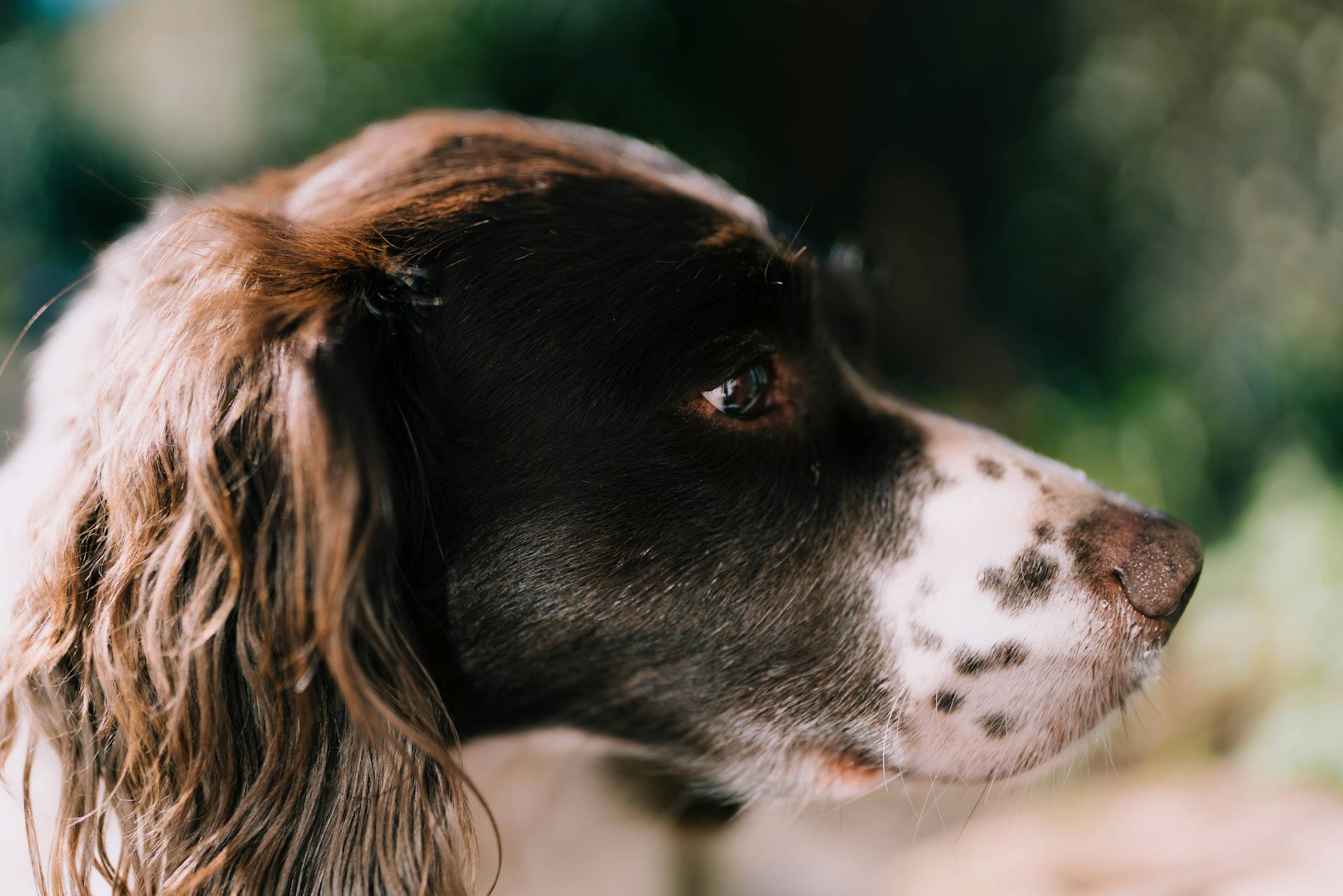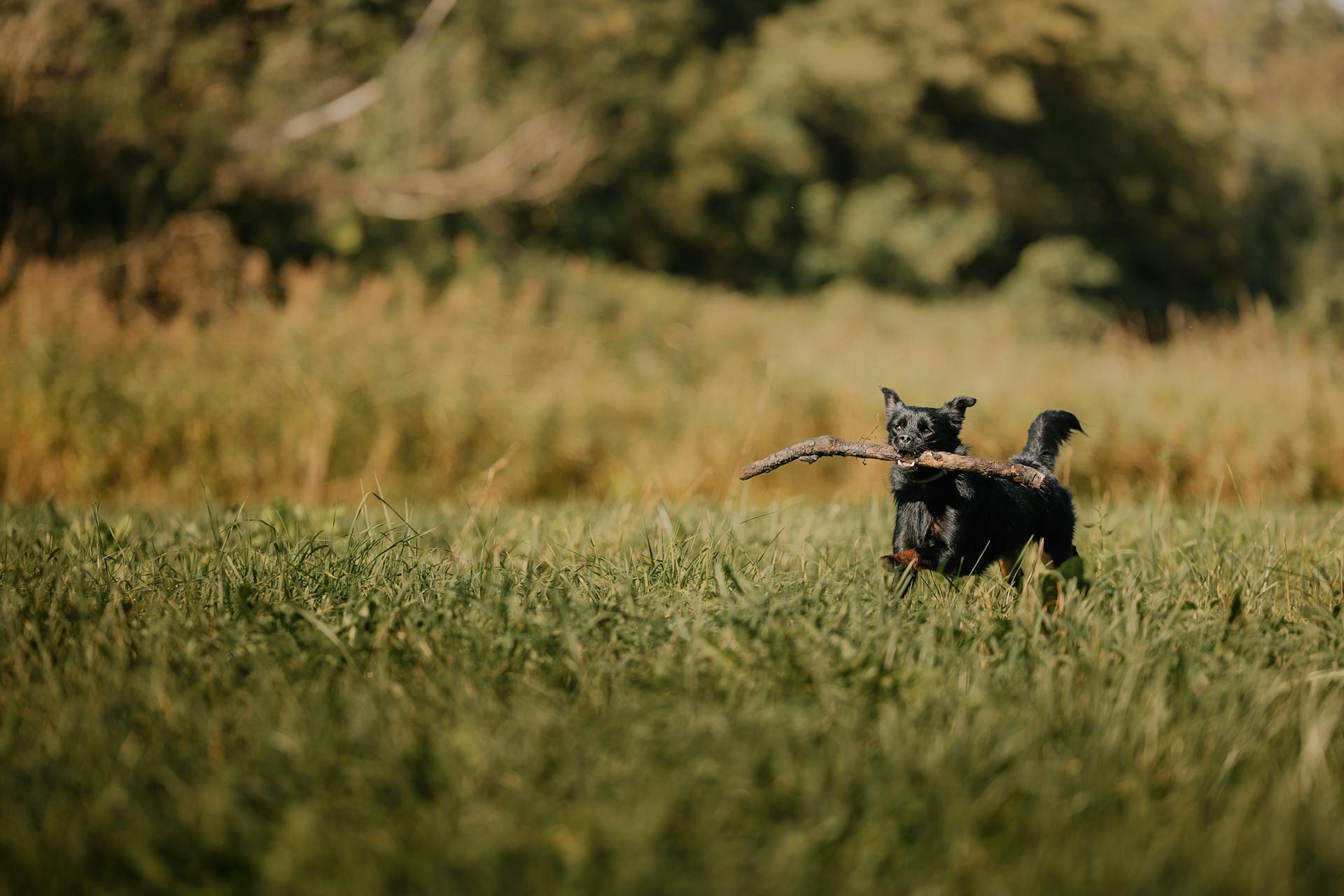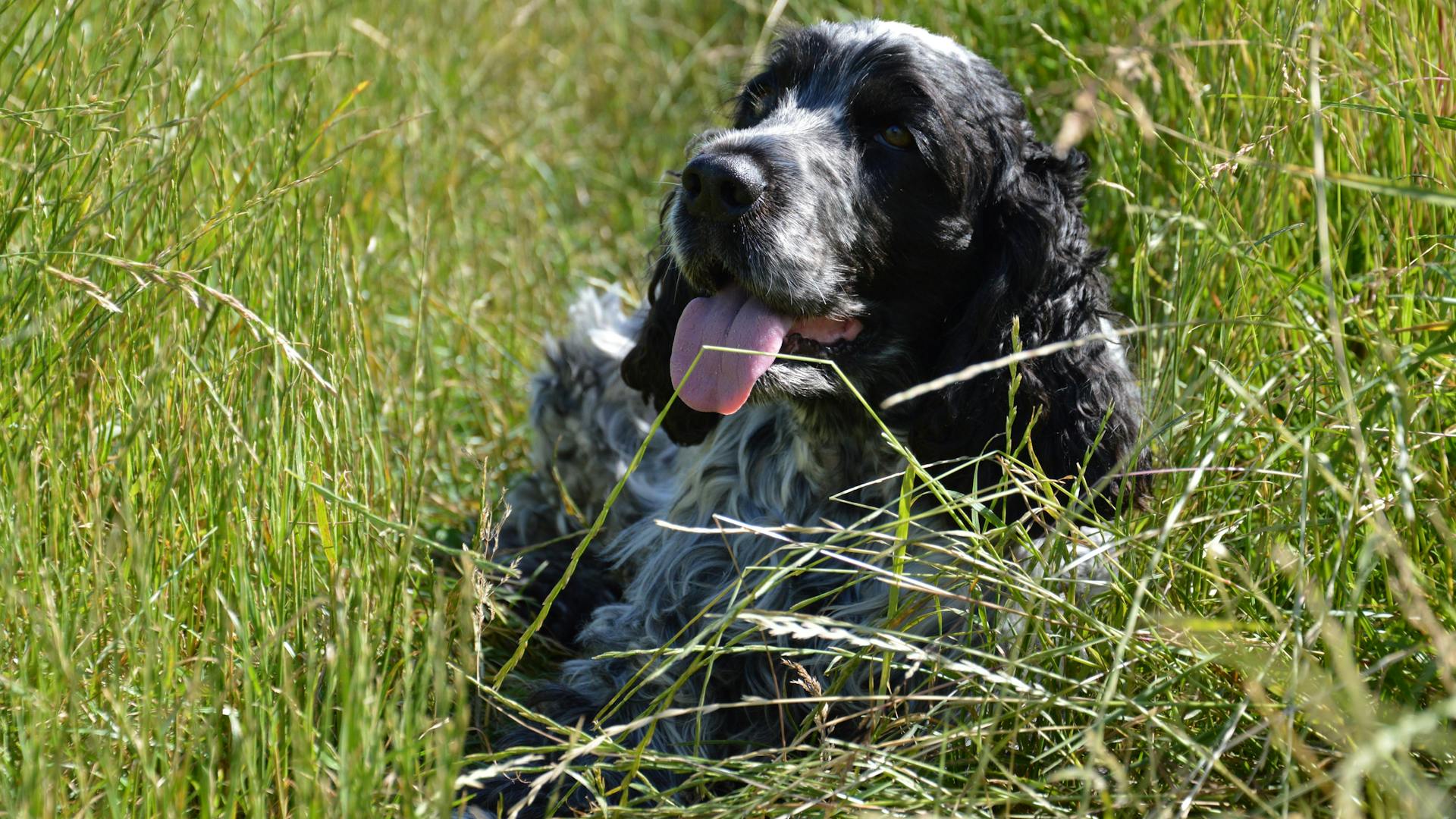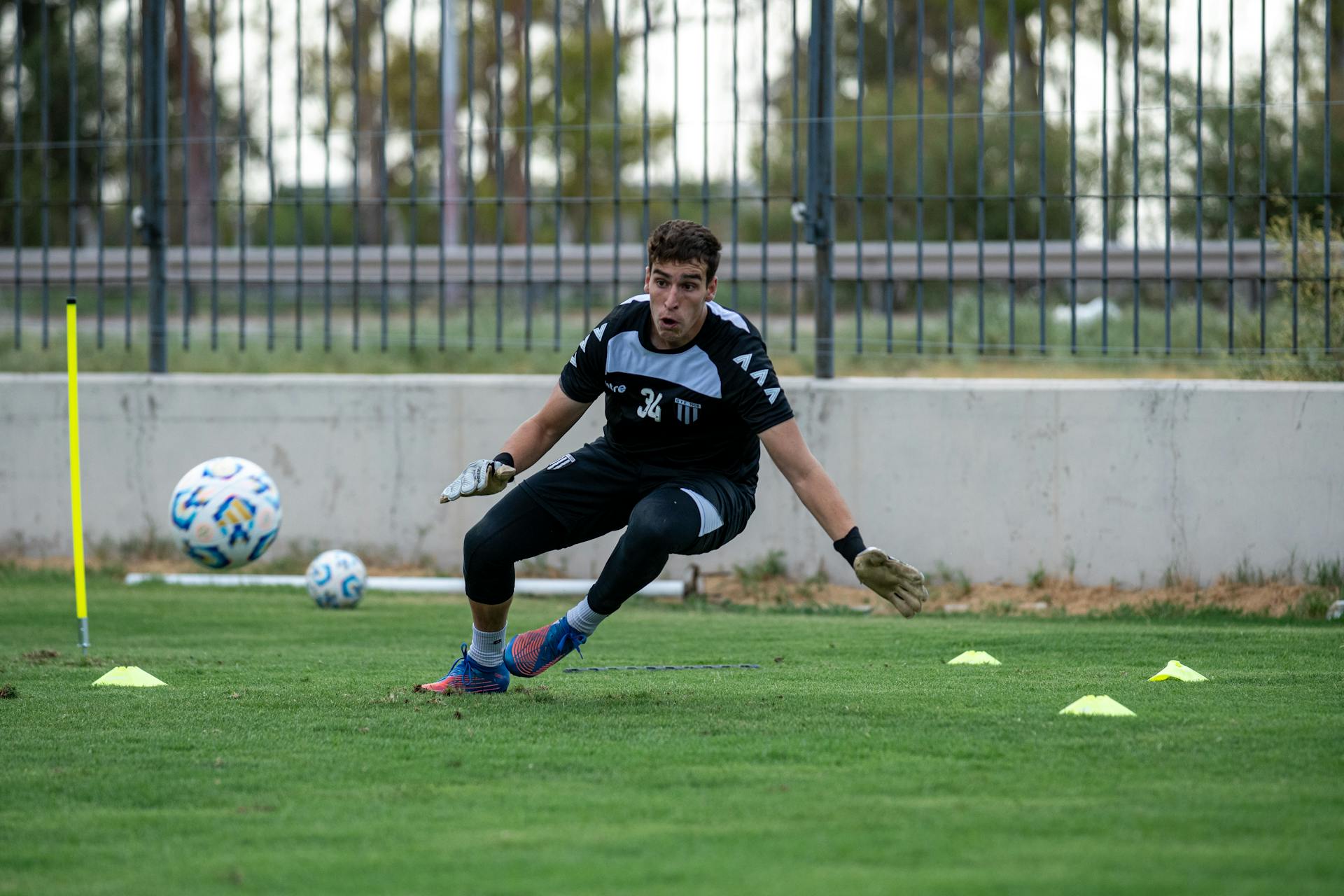
The Field Springer Spaniel is a beloved breed known for its exceptional hunting ability and charming personality. They are a medium-sized dog with a sturdy build and a short, dense coat that requires regular grooming.
Their friendly and outgoing nature makes them a great addition to active families. They are highly social dogs that thrive on interaction and attention from their human family members.
Originating from England, the Field Springer Spaniel was bred to hunt game, specifically birds, and their strong prey drive is still evident today. They are natural retrievers and love to please their owners, making them highly trainable.
A typical day for a Field Springer Spaniel should include plenty of exercise and mental stimulation to keep them happy and healthy. With a lifespan of around 12-14 years, they are a long-term companion that requires patience, love, and care.
You might like: Dogs Breeds That Start with B
Physical Characteristics
Field Springer Spaniels are a medium-sized breed, typically ranging between 19 and 20 inches in height and 40 to 50 pounds in weight.
Their coats are moderately long with feathering on the legs and tail, and can vary in coarseness. Field-bred dogs tend to have shorter, coarser coats than show-bred dogs.
The ears of Field Springer Spaniels are less pendulous than those of show-bred dogs, and the tail may be docked a few inches shorter in field-bred dogs.
Field-bred dogs are wiry and have a more feral look than those bred for showing, and are selected for their sense of smell, hunting ability, and response to training rather than appearance.
Here's a comparison of the typical sizes of Field Springer Spaniels and show dogs:
The English Springer Spaniel is similar to the English Cocker Spaniel, but tends to have shorter, higher-set ears and a longer muzzle.
History
The English Springer Spaniel has a rich history that dates back to the 19th century. The breed was initially developed to serve as a hunting dog, with smaller cocker spaniels used to hunt woodcock and their larger littermates used to "spring" gamebirds into the air.
In the early days, spaniel breeds were often developed in specific counties or by nobility, resulting in distinct strains like the Norfolk and Shropshire spaniels. These larger land spaniels were said to be of "true springer type" and were eventually shown under the breed name of Norfolk spaniel.
By the late 1800s, the English Springer Spaniel breed was taking shape, with the Spaniel Club of England and the Sporting Spaniel Society holding joint trials in 1899. This marked an important milestone in the breed's development.
The English Kennel Club officially recognized the English Springer Spaniel breed in 1902, combining physical and ability standards from the two organizations. The American Kennel Club followed suit in 1910.
Check this out: American Kennel Club Lancashire Heeler
Temperament and Abilities
English Springer Spaniels love to be put to work and are eager to please, making them an ideal family pet.
Regular exercise and enriching activities are key to keeping their gentle and amenable temperament. They thrive on physical and mental activity, and 20 minutes of mental exercise can be as effective as 40 minutes of physical exercise.
Springers are friendly, and they might bark to communicate readiness to play or to greet other dogs or humans. They're not known for excessive barking, but it can develop if their exercise or socialization needs aren't met.
For your interest: How Much Exercise Do Labrador Retrievers Need
Abilities

An English Springer Spaniel is a versatile breed that excels in various activities. They have a strong work ethic and can thrive in a variety of roles, from hunting to therapy work.
Their trainability is a key component of their abilities, and they respond well to mental stimulation. Joy cites that 20 minutes of mental exercise can be as effective as 40 minutes of physical exercise in tiring a Springer.
Springers have a natural quartering pattern that allows them to effectively hunt within gun range. They use the wind to their advantage in locating game, and their biddability makes them a valuable asset in the field.
Their primary role is as a game bird flushing dog, and they are trained to perform several essential skills. These include:
- Retrieve to Hand: Springers are trained to deliver birds to hand, holding the bird until told to give it to the hunter directly.
- Soft Mouth: Springers are taught to deliver game with a soft mouth, ensuring the bird is fit for the table.
- Quarter: Springers work in a zig-zag pattern in front of the hunter, seeking game birds and staying within gun range.
- Scenting: Springers have a good nose in both wet and dry conditions, allowing them to locate game effectively.
- Flushing: Springers should have a positive flush, not hesitating or pointing when encountering game.
- Hup: Springers are trained to sit and stay on command, allowing the handler to direct them.
- Follow Hand Signals: Springers respond to hand signals, allowing the hunter to direct them into areas of particular interest.
- Steady: Springers should be steady to wing and shot, sitting when a bird rises or a gun is fired.
- Blind Retrieve: Experienced Springers can be trained to use all their attributes to retrieve lost game birds.
Personality and Temperament
English Springer Spaniels are do-it-all and eager-to-please breeds that thrive on being put to work. They require time and patience, especially when they're young.
Regular exercise and enrichment activities are essential to maintaining their gentle and amenable temperament. This means they'll be a great fit for families who can dedicate time to their needs.
Springers can adapt to different living environments as long as their exercise and enrichment needs are met. However, they might not be the best fit for people who are away from home for extended periods.
A friendly breed by nature, English Springer Spaniels love to spend time with humans young and old. They'll often bark to communicate readiness to play or to greet other dogs or humans.
While they're not known for excessive barking, it can develop if their exercise or socialization needs aren't met.
Consider reading: Best Time to Breed Dog in Heat
Pet Care
English Springer Spaniels are bred to be working dogs and need plenty of exercise and mental stimulation to stay happy and healthy.
They love having a job to do and will thrive with regular training and routine exercise. A big backyard or a park is perfect for them to stretch their fast-moving legs.
Their medium-length, weather-proof coat needs a brushing once or twice a week to prevent mats and tangles. Regular professional grooming can also keep their fur lustrous.
English Springer Spaniels shed like many other breeds, so be prepared for regular grooming sessions. They tend to retain their vigor into old age, with an average lifespan of 12–14 years.
Their social nature makes them eager to please and spend time with their humans. With proper care, they can lead healthy, happy lives.
Health and Nutrition
Feeding your field Springer Spaniel requires attention to their high energy needs. You should feed them a high-quality, calorically dense diet to keep them going throughout the day.
Their age and lifestyle will determine how often to feed them, typically at least three times a day for puppies and twice a day for adults. Always consult with your vet to confirm the best feeding schedule for your dog.
To ensure you're feeding the right amount, follow the manufacturer's recommendations on the dog food bag and check with your vet to confirm. Factors like their weight, activity level, and lifestyle will influence their portion sizes.
You might enjoy: Shiba Inu One Cent
Health Issues

Genetic-based disorders are not uncommon in some breeds, but most are not life-threatening and can be managed.
English Springer Spaniels are one of them, where genetic-based disorders are a concern. Some of these disorders can be more serious, however.
Most genetic-based disorders in dogs can be managed with proper care and attention. This means regular check-ups with the vet and a healthy lifestyle for your pet.
Some of these disorders can be more serious, but they're not life-threatening. This is good news for dog owners who want to give their pets the best life possible.
Nutritional Tips
To keep your English Springer Spaniel's joints healthy, consider supplementing with glucosamine and chondroitin, especially if they're involved in sporting activities.
Always talk with your vet before giving your dog nutritional supplements, as they can recommend the best course of action.
Choose a high-quality, calorically dense diet that's approved by the Association of American Feed Control Officials (AAFCO) for your dog's current life stage.

Because Springers are active dogs, a high-quality diet is essential to keep them energized and healthy.
Feed your English Springer Spaniel puppy at least three times a day on a consistent schedule, while adults should eat twice a day.
Follow the manufacturer's recommendations on the dog food bag for the total amount of food to give your pup over a 24-hour period.
Check with your vet to confirm you're feeding your English Springer Spaniel the right amount, as this can vary depending on their lifestyle, age, weight, and activity level.
Protect your Springer's joint health by adding omega-3 supplements to their diet, which can also help keep their skin and coat lush and soft.
Consult with your vet on the best feeding schedule and diet for your pet's specific needs.
Broaden your view: German Shorthaired Pointer Diet
Training
Training is key for a field Springer Spaniel. They're intelligent and respond well to patient, gentle training tactics.
Early training and socialization are very beneficial for the breed. This sets them up for success in their future roles as hunting companions.
Treats are often a good motivator for Springer Spaniels. They love to please their handlers and will work hard for rewards.
Springers are natural retrievers, and their instincts can be further developed by their handle or trainer. This means they'll excel in water work and retrieving.
In field trials, Springers are required to complete their retrieves as part of the scoring. This includes back-to-back retrieves in open water.
To be titled, Springers must pass a water test, which involves two back-to-back retrieves of dead game.
A different take: Straight Backed German Shepherds
Frequently Asked Questions
What is the difference between field and bench Springer Spaniels?
Field Springer Spaniels have a lighter coat and docked tail, while bench Springer Spaniels have a longer, thicker coat with more feathering, reflecting their different purposes in hunting and the show ring
What is a field bred springer spaniel?
Field bred Springer Spaniels are bred for their hunting ability and soundness, resulting in a more varied appearance. With proper socialization and training, they can make wonderful companions.
Sources
- https://en.wikipedia.org/wiki/English_Springer_Spaniel
- https://www.petmd.com/dog/breeds/english-springer-spaniel
- https://projectupland.com/hunting-dogs/english-springer-spaniel/
- https://www.akc.org/dog-breeds/english-springer-spaniel/
- https://showsightmagazine.com/love-field-bred-english-springer-spaniels/
Featured Images: pexels.com


